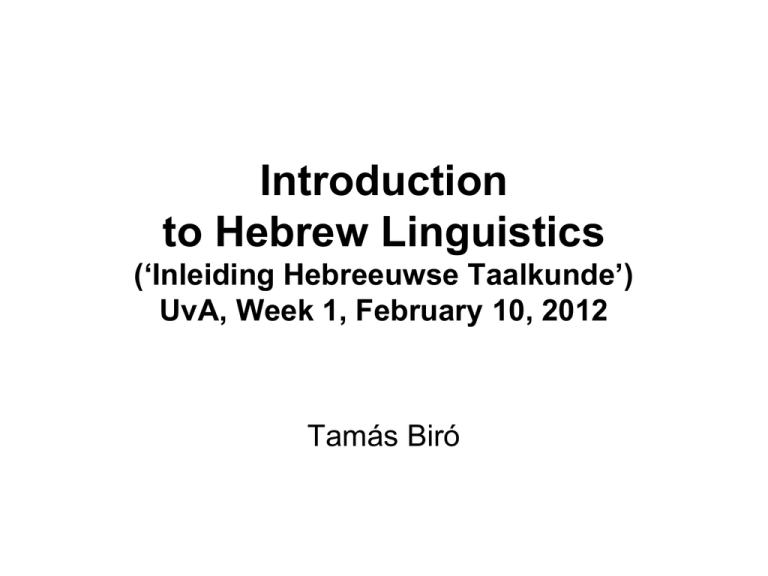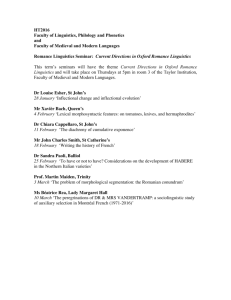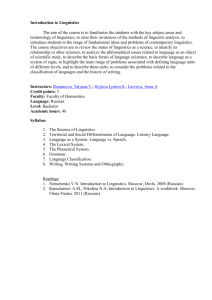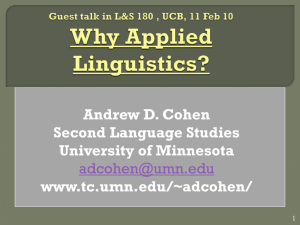ppt
advertisement

Introduction to Hebrew Linguistics (‘Inleiding Hebreeuwse Taalkunde’) UvA, Week 1, February 10, 2012 Tamás Biró Contact info • • • • Tamás Biró t.s.biro@uva.nl http://home.medewerker.uva.nl/t.s.biro/ Course material (slides, readings, etc.): http://www.birot.hu/courses.php http://www.birot.hu/courses/2012-introhb/ (username, passwd) Do the anonymous test. 2 Goals of this course 1. Basics of “Hebrew linguistics”: a. Semitic linguistics, Hebrew in the Semitic context. b. (Socio)-historical development of Hebrew. c. Descriptive of and theoretical linguistics on Hebrew. 2. General cultural, socio-historical background. 3. Supporting Hebrew language skills: a. Reflections on skills acquired in the past. b. Refreshing forgotten details. c. Preparing future courses (rabbinic Hb, Aramaic, Yiddish). Course program: Block 1: history of the Hebrew language • Week 1: Introduction. Goals of the course. Why (Hebrew) linguistics? Different approaches to language. A general overview of the course. Four main periods of the Hebrew language. • Week 2: The Afro-Asiatic and the Semitic context, including an introduction to comparative and historical linguistics. • Week 3: NW-Semitic, Tell-Amarna, Proto-Hebrew. • Week 4: History of the alphabetic writing systems. Epigraphy and inscriptions from the first Temple period. • Week 5: Biblical Hebrew (pre-classic, classic, post-exilic). The postbiblical period and Qumran. Samaritan Hebrew. • Week 6: Rabbinic Hebrew (Mishna, Talmud, midrashim). Aramaic: a quick overview and its role in the history of Hebrew. • Week 7: Medieval Hebrew: piyyutim, codices, commentaries. Code switching, pidgin and creole languages. The Judeo-languages. 4 Course program: Block 2: descriptive and historical linguistics • Week 8: Haskala and the revival of the Hebrew language. • Week 9: The Israeli (Hebrew) language, sociolinguistics: language contact, borrowing, foreign influences; language planning. • Week 10: Lexicon. • Week 11: Phonology. • Week 12: Morphology. • Week 13: Syntax and semantics. (If time permits) psycholinguistics and computational linguistics. • Week 14: Is Israeli (Hebrew) a Semitic language? Summary. 5 Requirements • Weekly assignments: 20% – – – – – – – Goal: to prepare the next topic. 12 assignments, best 10 counts. 2 p (good) / 1 p (not really) / 0 p (unacceptable). Minimum 10 points required for final grade. Deadline: Thursday noon (12:00). Email to: t.s.biro@uva.nl. Also accepted in Dutch. • Take-home exam during middle semester break: 30% • Final exam (during the exam period): 50% – Slides, readings, assignments. 6 Readings Available from http://www.birot.hu/courses/2012-introhb/. • Chaim Rabin: A Short History of the Hebrew Language (1973). • Various chapters from various books. • Some weekly assignments based on articles. • For course ‘Intro to general linguistics’: R. Appel et al (eds): Taal en Taalwetenschap. 7 Let’s get started: Intro to linguistics (cf. your other course) •Rabin: A Short History…1973:5. •Points to note: -approach history -phonology, morphology, syntax -vocabulary -writing, spelling -language of sources -language contacts -history of the people -history of the discipline Why interested in linguistics? • Aristotle and philosophers of language since: - Philosophical questions: what is meaning (of a sentence, of a word)? - Tool for other fields of philosophy: rhetoric, poetics, aesthetics… • (Late antiquity and) Middle Ages (and since): - “Philology”: tool to decipher the meaning/message of (old and/or holly) texts • (Late 18th) and 19th century: language as a historical phenomenon - Historical linguistics (tool for history: history of language ≈ history of people) • Early 20th century: language a sign; language as a social phenomenon - Structuralism (uncover structure of language), semiotics (study of signs) • Since 1957 (Noam Chomsky): language as a biological phenomenon - Generative linguistics; the cognitive turn: information processing in the brain. (Contemporary developments: balancing between different approaches.) 9 An over-simplified history of linguistics Middle Ages “Philological” linguistics Linguistics is a tool to… Language belongs to… …analyze (holy) texts. … a text or author. Tamás Biró: Linguistics as a Model for the Cognitive Approaches… 10/27 An over-simplified history of linguistics Middle Ages “Philological” linguistics End 18th and Historical 19th century linguistics Linguistics is a tool to… Language belongs to… …analyze (holy) texts. … a text or author. … the history of a nation. … a nation or people. Tamás Biró: Linguistics as a Model for the Cognitive Approaches… 11/27 An over-simplified history of linguistics Linguistics is a tool to… Language belongs to… …analyze (holy) texts. … a text or author. End 18th and Historical 19th century linguistics … the history of a nation. … a nation or people. 1st half of 20th century … studying human signs. … a society, population. Middle Ages “Philological” linguistics Structuralist linguistics Tamás Biró: Linguistics as a Model for the Cognitive Approaches… 12/27 An over-simplified history of linguistics Linguistics is a tool to… Language belongs to… …analyze (holy) texts. … a text or author. End 18th and Historical 19th century linguistics … the history of a nation. … a nation or people. 1st half of 20th century Structuralist linguistics … studying human signs. … a society, population. 2nd half of 20th century Generative linguistics … studying human brain. … a brain or a species. Middle Ages “Philological” linguistics Tamás Biró: Linguistics as a Model for the Cognitive Approaches… 13/27 Why interested in linguistics? • Tool for: • philosophy • exegesis: religious or literary • history • sociology • semiotics • biology, psychology, brain science • language technology • language teaching Aim in itself: • understand language as a system – expressing thought – changing in time – of signs (socially agreed) – reflecting social facts – implemented in the brain – encoding information – learned/acquired without effort 14 Why interested in linguistics? • Prescriptive approach: to know what is “correct”. • Descriptive approach: to know what is there. Stages: - Describe the facts: synchrony vs. diachrony Then: - Explain the facts (why? for instance, create models) - or interpret the facts - or make use of the fact (in another discipline or in real application) 15 Answering Why’s in linguistics Given a (linguistic) observation: why is it so? • Because it has developed so: historical explanations. • Because this is how it is encoded in the brain: cognitive explanations. • Because this is how it can fulfill its (social) function(s): functional explanations. • Because this is how the child can learn it. • … • By coincidence: Quite often the best answer, don’t be afraid of it! 16 Fields of linguistcs “Core fields” • Levels of the linguistics structure: • (Phonetics) ------------------------------------- • Phonology • Morphology • Syntax • Semantics ------------------------------------- • Lexicon/vocabulary • Pragmatics, discourse “Peripheral fields”: • Connected to external disciplines, or at least research methods: – Phonetics (biology, physics) – Psycholinguistics – Neurolinguistics, clinical linguistics – Computational linguistics, language technology – Sociolinguistics, dialectology – (Etymology) 17 Two dimensions: synchrony (one state) vs. diachrony (change) 1500 BCE 500 BCE 200 CE 1200 CE 1948 2012 Phonology (vowels, consonants…) Morphology (nouns, verbs…) Syntax and semantics Lexicon (affixes, words, multi-word expressions…) Literature, available sources Socio-historical context (contact with others…) 18 Two dimensions: synchrony (one state) vs. diachrony (change) 1500 BCE 500 BCE 200 CE 1200 CE 1948 2012 Phonology (vowels, consonants…) Morphology (nouns, verbs…) Syntax and semantics Lexicon (affixes, words, multi-word expressions…) Literature, available sources Socio-historical context (contact with others…) 19 Two dimensions: synchrony (one state) vs. diachrony (change) 1500 BCE 500 BCE 200 CE 1200 CE 1948 2012 Phonology (vowels, consonants…) Morphology (nouns, verbs…) Syntax and semantics Lexicon (affixes, words, multi-word expressions…) Literature, available sources Socio-historical context (contact with others…) 20 Two dimensions: synchrony (one state) vs. diachrony (change) 1500 BCE 500 BCE 200 CE 1200 CE 1948 2012 Phonology (vowels, consonants…) Morphology (nouns, verbs…) Syntax and semantics Lexicon (affixes, words, multi-word expressions…) Literature, available sources Socio-historical context (contact with others…) 21 Hebrew: prehistory and four periods 0. Proto-Semitic, proto-NW-Semitic, proto-Canaanite, and proto-Hbrw: “The family tree: ancestors and relatives.” 1. Biblical Hebrew: “Did King David speak like the Bible?” Pre-classical BH, classical BH, post-exilic BH; Qumran Masoretic Hebrew = Tiberian Hebrew 2. Mishnaic/Rabbinic Hbrw: “A spoken language written”. 3. Medieval Hebrew: “Dead or alive?” 4. Modern Hebrew, Israeli Hebrew (Israeli language) Haskala, language revival, contemporary IH “Is it obvious that Hebrew is the language of Israel?” 22 Other languages • Aramaic • Ancient Aramaic, Imperial Aramaic • Eastern and Western middle Aramaic(s) • Talmud (and some midrashim); Zohar; liturgy • Judeo-languages • • • • • • J-Aramaic (from Biblical Arm. to Jewish modern Arm.) Judeo-Greek (from Hellenistic Greek to Yevanit) Judeo-Arabic Yiddish Judesmo/Ladino/Judeo-Spanish and many other… as well as Karaim. 23 Comparing languages: Contacts or no contacts? This is the question • Similarity between to languages can be due to: • Common ancestor (Proto-Semitic *shalaam > Hebr. shaloom ~ Arabic salaam) • Language contact, areal and cultural factors (borrowings: Hebr. ~ שקEngl. sack; Hebr. ~ טלוויזיהEng. television) • Language universals: [t] sound in both Hebrew and Dutch. • Language typology: 2 genders in both Hebrew and French. • Chance: suffix –i to derive adjectives from geographic nouns in both Hebrew and Hungarian: Hebr. ~ ישראליHung. izraeli ‘Israeli’. NB: observe conventional notations: [t], ~, example ‘meaning’, *, >. 24 Sources of linguistics • (Prescriptive linguistics: the “Academy”) • Modern linguistics: • whatever the native speaker says. • observations and controlled experiments. • adults, children, L2 learners… • But what about past languages? • • • • • Written documents only. No tape rec. No chance to ask. Written style often differs from oral style. Copyist’s errors. Universals of Homo sapiens also apply to older languages. Comparison with related languages: e.g., cognates. Internal reconstruction: irregularities explained by regular form in past? 25 Questions in Hebrew linguistics • • • • How can we reconstruct the earlier stages of Hebrew? Which sources are more reliable? (E.g., MT vs. LXX) Did written sources reflect the spoken language? Was/is spoken language influenced by the corpus whose language is normative? • Did the language change differently when it was used only as L2? (Medieval Greek, Latin, Hebrew) • When was actually Hebrew used as L1? What other languages were used by Jews? Diglossia, bilingualism and code switching. 26 Code switching: What language(s) are they speaking? • Football: http://www.youtube.com/watch?v=wwvbJSnf_AE • Parashat ha-shavua: http://www.youtube.com/watch?v=ZnTUGoEmhhA • Munkatcher rebbe: http://www.youtube.com/watch?v=ucL9pM0G7wU • Rosh hashana: http://www.youtube.com/watch?v=J2vNRJ2HZ3g What is in Hebrew? What sounds like Hebrew? Similarities and differences between the speakers? 27 For next week: Read: Chaim Rabin: A Short History of the Hebrew Language (1973), pp. 5-24. (Available from http://www.birot.hu/courses/2012-introhb/.) Warnings: - Written in 1973: not state-of-the-art in 2012. - Slight ideological biases: religious, national. Question: have you observed such a bias? 28 Assignment for next week Invite a Semitic speaker for a drink! • • • • • • Arabic (classical? Moroccan? Egyptian? else?), or else. Make “fieldwork”: collect information on that language. Then, contrast it to Hebrew: similarities, differences. Vocabulary: most frequent words, numbers, pronouns... Sounds. (Not the same as letters!) Writing system. Morphology: Gender and number of nouns, adjectives. Past and future tense of verbs. Are there prefixes or suffixes? If yes, what are they? Are there binyanim? • And many more things... 29 Assignment for next week Invite a Semitic speaker for a drink! • Sociolinguistic background: Which languages does (s)he speak in everyday life? Which language is used in what context? Are there different emotions associated with different languages? • Summary in an email by Thursday noon: t.s.biro@uva.nl. Subject: Assignment 1. • (At most 1 page. Preferably no attachment.) • Can be done in small groups, but separate emails. 30 See you next week!







